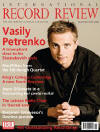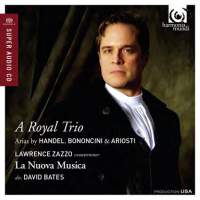Reviewer: John
T Hughes
The note by David Vickers
concentrates on the background to the music on this disc but is followed by
a sentence which tells purchasers that if they want discussion 'of the
dramatic contexts and music of the arias' the must visit Harmonia Mundi's
website. Tut, rut! We did but could find nothing. My second comment is my
old bugbear that a CD promising arias should not contain ten minutes' worth
of orchestral music. Two more arias could have occupied that space. In a
'performer's note', Lawrence Zazzo states that 'Cosi stanco Pellegrino' from
Bononcini's Crispo exists in three versions, which he and conductor
David Bates incorporated into a hybrid aria, thus presenting something never
heard before as such. Could not all three (or at least two of them) have
been included instead of the non‑vocal items?
Having said that, I must
acknowledge that the Overture to Ariosti's Vespasiano is a bracing
affair with much work for the brass, engagingly played by La Nueva Musica
under Bates, himself a countertenor. (I heard him in Handel's Esther
in St James's, Piccadilly, in London, where Leopold Stokowski was organist
from 1902 to 1905.) The first aria is from Handel's Flavio, a fast
piece with a slow middle section that includes a haunting oboe. Zazzo
negotiates the swift runs with assurance. Of the excerpts from Crispo, 'Cosi
stanco Pellegrino' is a lament, rather low-lying for the most part and
drawing Zazzo's warmest tone. It is sung by Crispo himself, but the second
aria, actually from earlier in the opera, is for his half‑brother Costante
and as its title, 'Torrente che scende', suggests it is quite different from
the lament. It is expressed in full voice, rich in colour, with the
orchestral accompaniment matching it with blazing horns and other wind
instruments to support the singer.
Possibly the most well known
of Bononcini's arias these days is 'Per la Gloria d'adorarvi', recorded by a
number of singers, including Luciano Pavarotti, even though it is
sung by Griselda. Despite the cross‑dressing, Pavarotti sang it elegantly
but without the ornamentation that Zazzo includes in his attractive
rendition. The last Bononcini selection is that from Muzio Scevola, a
1721 work whose second act was written by him, the first by Filippo Amadei
and the third by Handel. 'Tigre piagata' covers a wide range, taking Zazzo
to his darker timbre. Muzio likens himself to a tiger which 'does not mind
death if it first achieves revenge by killing the buntsman'. The CD’s title,
'A Royal Trio', refers to the three composers here writing for the Royal
Academy of music in London. From Ariosti's pen comes Il naufragio vicino,
which is not listed among his operas in The Viking Guide to opera
and may be a stand‑alone aria, about a sailor fearing the storm. Again
Zazzo's strongest tone is impressive as the vocal line moves at a slower
tempo over the scurrying orchestra. Ariosti puts the orchestra in often
low‑lying music in the recitative 'Spirate, o iniqui marmi' and the
succeeding aria 'Voi d'un Figlio' in his Coriolano as the imprisoned
hero regrets the grief of his lover Volunnia and mother Veturia. Zazzo is in
rich, vibrant voice for this long scene, steady and resounding, as befits
the character. In the dramatic accompanied recitative 'Orride larve!' from
the opening scene of Handel's 1727 opera, Admeto is near to death and curses
the tormenting Furies. It leads to 'Chiudetevi miei lumi', one of those
sheerly beautiful slow arias of which Handel was a master, a piece in which
a smooth and steady performance is essential. (Is someone going to tell me
that Handel 'borrowed' it from another composer?) It receives such from
Zazzo: a gentle flow of warm and soothing tone. One of Handel's great
contributions is 'Va tacito e nascosto', with Giulio Cesare seeing himself
as a hunter stalking his prey, in this case Tolomeo. Horns are prominent to
splendid effect. Zazzo is once more in admirable voice and decorates the
da capo. The longest aria is 'Tanti affanni', a slow movement in which
Ottone sings of his lover Teofane, who has been kidnapped, and of his
despair. This is a subdued solo, in which the central section matches the
outer ones in tempo, and Zazzo himself continues the high standard of his
singing on other tracks. Far different is the choice which ends the disc.
This is the bravura aria 'Vivi, tiranno' from Rodelinda, to whose
da capo Zazzo adds plenty of decoration and executes it with vitality
and clarity. This is an accomplished recital from both singer and orchestra,
the latter playing freshly under Bates's direction in a programme which
contains some rarely heard music, such as the Ariosti pieces. (Apart from an
aria from his Artaserse sung by Aris Christofellis on EMI, how often
have his operas been represented on record?) The warm recording was made in
St John's, Smith Square, London.
Fermer la fenêtre/Close window |




